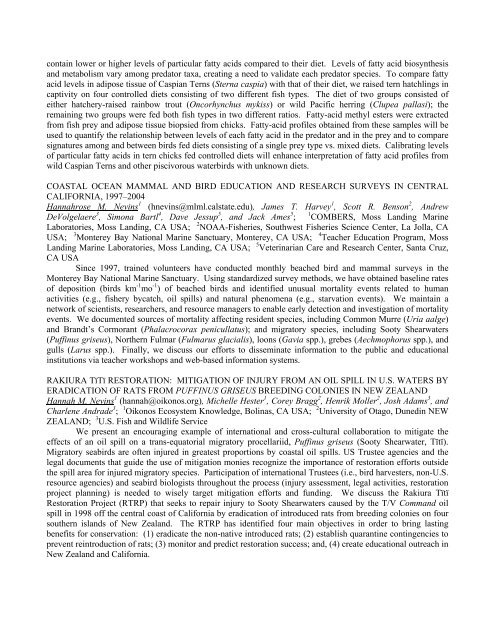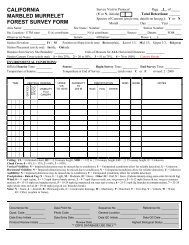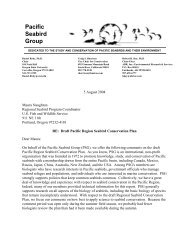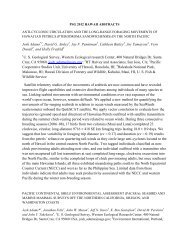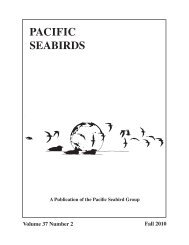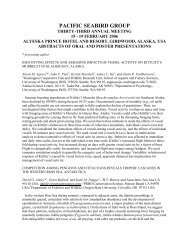abstracts of oral and poster presentations - Pacific Seabird Group
abstracts of oral and poster presentations - Pacific Seabird Group
abstracts of oral and poster presentations - Pacific Seabird Group
You also want an ePaper? Increase the reach of your titles
YUMPU automatically turns print PDFs into web optimized ePapers that Google loves.
contain lower or higher levels <strong>of</strong> particular fatty acids compared to their diet. Levels <strong>of</strong> fatty acid biosynthesis<br />
<strong>and</strong> metabolism vary among predator taxa, creating a need to validate each predator species. To compare fatty<br />
acid levels in adipose tissue <strong>of</strong> Caspian Terns (Sterna caspia) with that <strong>of</strong> their diet, we raised tern hatchlings in<br />
captivity on four controlled diets consisting <strong>of</strong> two different fish types. The diet <strong>of</strong> two groups consisted <strong>of</strong><br />
either hatchery-raised rainbow trout (Oncorhynchus mykiss) or wild <strong>Pacific</strong> herring (Clupea pallasi); the<br />
remaining two groups were fed both fish types in two different ratios. Fatty-acid methyl esters were extracted<br />
from fish prey <strong>and</strong> adipose tissue biopsied from chicks. Fatty-acid pr<strong>of</strong>iles obtained from these samples will be<br />
used to quantify the relationship between levels <strong>of</strong> each fatty acid in the predator <strong>and</strong> in the prey <strong>and</strong> to compare<br />
signatures among <strong>and</strong> between birds fed diets consisting <strong>of</strong> a single prey type vs. mixed diets. Calibrating levels<br />
<strong>of</strong> particular fatty acids in tern chicks fed controlled diets will enhance interpretation <strong>of</strong> fatty acid pr<strong>of</strong>iles from<br />
wild Caspian Terns <strong>and</strong> other piscivorous waterbirds with unknown diets.<br />
COASTAL OCEAN MAMMAL AND BIRD EDUCATION AND RESEARCH SURVEYS IN CENTRAL<br />
CALIFORNIA, 1997–2004<br />
Hannahrose M. Nevins 1 (hnevins@mlml.calstate.edu), James T. Harvey 1 , Scott R. Benson 2 , Andrew<br />
DeVolgelaere 3 , Simona Bartl 4 , Dave Jessup 5 , <strong>and</strong> Jack Ames 5 ; 1 COMBERS, Moss L<strong>and</strong>ing Marine<br />
Laboratories, Moss L<strong>and</strong>ing, CA USA; 2 NOAA-Fisheries, Southwest Fisheries Science Center, La Jolla, CA<br />
USA; 3 Monterey Bay National Marine Sanctuary, Monterey, CA USA; 4 Teacher Education Program, Moss<br />
L<strong>and</strong>ing Marine Laboratories, Moss L<strong>and</strong>ing, CA USA; 5 Veterinarian Care <strong>and</strong> Research Center, Santa Cruz,<br />
CA USA<br />
Since 1997, trained volunteers have conducted monthly beached bird <strong>and</strong> mammal surveys in the<br />
Monterey Bay National Marine Sanctuary. Using st<strong>and</strong>ardized survey methods, we have obtained baseline rates<br />
<strong>of</strong> deposition (birds km -1 mo -1 ) <strong>of</strong> beached birds <strong>and</strong> identified unusual mortality events related to human<br />
activities (e.g., fishery bycatch, oil spills) <strong>and</strong> natural phenomena (e.g., starvation events). We maintain a<br />
network <strong>of</strong> scientists, researchers, <strong>and</strong> resource managers to enable early detection <strong>and</strong> investigation <strong>of</strong> mortality<br />
events. We documented sources <strong>of</strong> mortality affecting resident species, including Common Murre (Uria aalge)<br />
<strong>and</strong> Br<strong>and</strong>t’s Cormorant (Phalacrocorax penicullatus); <strong>and</strong> migratory species, including Sooty Shearwaters<br />
(Puffinus griseus), Northern Fulmar (Fulmarus glacialis), loons (Gavia spp.), grebes (Aechmophorus spp.), <strong>and</strong><br />
gulls (Larus spp.). Finally, we discuss our efforts to disseminate information to the public <strong>and</strong> educational<br />
institutions via teacher workshops <strong>and</strong> web-based information systems.<br />
RAKIURA TïTï RESTORATION: MITIGATION OF INJURY FROM AN OIL SPILL IN U.S. WATERS BY<br />
ERADICATION OF RATS FROM PUFFINUS GRISEUS BREEDING COLONIES IN NEW ZEALAND<br />
Hannah M. Nevins 1 (hannah@oikonos.org), Michelle Hester 1 , Corey Bragg 2 , Henrik Moller 2 , Josh Adams 3 , <strong>and</strong><br />
Charlene Andrade 3 ; 1 Oikonos Ecosystem Knowledge, Bolinas, CA USA; 2 University <strong>of</strong> Otago, Dunedin NEW<br />
ZEALAND; 3 U.S. Fish <strong>and</strong> Wildlife Service<br />
We present an encouraging example <strong>of</strong> international <strong>and</strong> cross-cultural collaboration to mitigate the<br />
effects <strong>of</strong> an oil spill on a trans-equatorial migratory procellariid, Puffinus griseus (Sooty Shearwater, Tïtï).<br />
Migratory seabirds are <strong>of</strong>ten injured in greatest proportions by coastal oil spills. US Trustee agencies <strong>and</strong> the<br />
legal documents that guide the use <strong>of</strong> mitigation monies recognize the importance <strong>of</strong> restoration efforts outside<br />
the spill area for injured migratory species. Participation <strong>of</strong> international Trustees (i.e., bird harvesters, non-U.S.<br />
resource agencies) <strong>and</strong> seabird biologists throughout the process (injury assessment, legal activities, restoration<br />
project planning) is needed to wisely target mitigation efforts <strong>and</strong> funding. We discuss the Rakiura Tïtï<br />
Restoration Project (RTRP) that seeks to repair injury to Sooty Shearwaters caused by the T/V Comm<strong>and</strong> oil<br />
spill in 1998 <strong>of</strong>f the central coast <strong>of</strong> California by eradication <strong>of</strong> introduced rats from breeding colonies on four<br />
southern isl<strong>and</strong>s <strong>of</strong> New Zeal<strong>and</strong>. The RTRP has identified four main objectives in order to bring lasting<br />
benefits for conservation: (1) eradicate the non-native introduced rats; (2) establish quarantine contingencies to<br />
prevent reintroduction <strong>of</strong> rats; (3) monitor <strong>and</strong> predict restoration success; <strong>and</strong>, (4) create educational outreach in<br />
New Zeal<strong>and</strong> <strong>and</strong> California.


